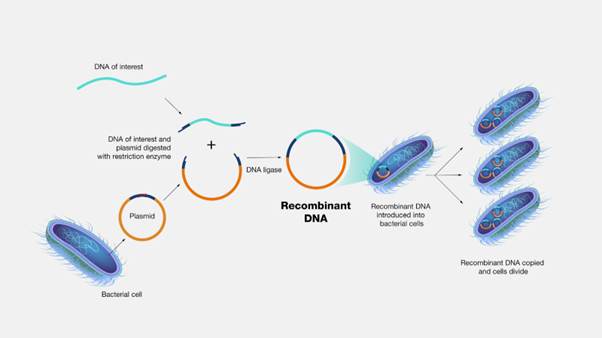Recombinant DNA technology (rDNA) has revolutionized the fields of genetics, biotechnology, and medicine. This powerful tool allows scientists to manipulate genetic material from different sources, creating new combinations of DNA that can lead to significant advancements in various fields. This article provides an in-depth overview of recombinant DNA technology, including its principles, applications, and examples.

Principles of Recombinant DNA Technology
Recombinant DNA technology involves several key steps that enable the manipulation and combination of genetic material:
1. Isolation of Genetic Material: The first step in creating recombinant DNA involves isolating the target DNA from its source. This could be genomic DNA, plasmid DNA, or DNA from other organisms.
2. Cutting DNA: Restriction enzymes are used to cut DNA at specific recognition sites. These enzymes create “sticky ends” or overhanging sequences that are complementary to each other. This allows for the precise joining of different DNA fragments.
3. Insertion of DNA: The desired DNA fragment, which could be a gene of interest or a specific sequence, is inserted into a vector. A vector is typically a circular piece of DNA, such as a plasmid or a bacteriophage, that can replicate within a host organism.
4. Ligation: DNA ligase is used to seal the fragments together, creating a recombinant DNA molecule. The sticky ends of the DNA fragment and the vector base pair with each other to form stable connections.
5. Transformation: The recombinant DNA is introduced into a recipient host cell (often a bacterial cell) through a process called transformation. Bacterial cells may require treatment to become “competent” to accept new DNA, using methods such as thermal shock or electroporation.
6. Selection and Screening: After transformation, cells that successfully incorporate the recombinant DNA are selected using antibiotic resistance markers or other selectable traits. Screening techniques are then used to confirm the presence of the recombinant gene.
Applications of Recombinant DNA Technology –
Recombinant DNA technology has numerous applications across various fields:
1. Medicine: Production of Insulin: One of the earliest and most significant applications of rDNA technology was the production of human insulin using genetically modified bacteria. In 1982, the U.S. Food and Drug Administration (FDA) approved Humulin, the first human insulin created through rDNA technology.
-
-
-
- Gene Therapy: This approach aims to treat genetic disorders by introducing healthy copies of genes into patients’ cells. For example, gene therapy has been explored for conditions like cystic fibrosis and hemophilia.
- Vaccines: Recombinant DNA technology is used to produce vaccines, such as the hepatitis B vaccine, which contains a portion of the viral protein produced in yeast cells.
-
-
2. Agriculture:
-
-
-
- Genetically Modified Organisms (GMOs): rDNA technology enables the creation of genetically modified crops with desirable traits such as pest resistance and increased yield. For instance, Bt cotton is engineered to express a bacterial toxin that protects against bollworm infestations.
- Flavr Savr Tomatoes: These tomatoes were one of the first commercially grown GMOs designed to have a longer shelf life by delaying ripening.
-
-
3. Research: Recombinant DNA technology is fundamental in molecular biology research for cloning genes, studying gene function, and producing proteins for laboratory studies. It allows scientists to create models for human diseases by engineering animal models with specific genetic mutations.
4. Biotechnology: In bioremediation, genetically modified microorganisms are developed to degrade environmental pollutants. Production of enzymes for industrial processes (e.g., proteases in detergents) often utilizes rDNA techniques to enhance enzyme properties.
Examples of Recombinant DNA Technology
1. Human Insulin Production: The production process involves inserting the human insulin gene into E. coli bacteria using plasmids as vectors. The bacteria then produce insulin, which can be harvested and purified for medical use.
2. Gene Therapy Trials: Clinical trials have demonstrated promising results in treating inherited disorders like spinal muscular atrophy by delivering functional copies of genes directly into patients’ cells.
3. GloFish: These genetically modified zebrafish were engineered to express fluorescent proteins from jellyfish and coral genes, making them glow under ultraviolet light. They serve as an example of rDNA technology applied in aquaculture and pet industries.
4. Golden Rice: Developed to combat vitamin A deficiency in developing countries, Golden Rice is genetically engineered to produce beta-carotene in its grains by incorporating genes from daffodils and E. coli.
5. Monoclonal Antibodies: Recombinant techniques are used to produce monoclonal antibodies for therapeutic purposes in cancer treatment and autoimmune diseases by fusing myeloma cells with antibody-producing B cells.
Ethical Considerations and Challenges
While recombinant DNA technology offers numerous benefits, it also raises ethical concerns regarding genetic manipulation:
-
- Biosafety Concerns: The release of genetically modified organisms into the environment poses risks that need careful assessment.
- Ethical Implications: Gene editing technologies like CRISPR raise questions about designer babies and unintended consequences on ecosystems.
- Regulatory Frameworks: Establishing clear regulations for genetic engineering practices is essential for public safety while promoting innovation.
Conclusion
Recombinant DNA technology has transformed modern science and medicine by enabling precise genetic manipulation with far-reaching applications in healthcare, agriculture, research, and biotechnology. From producing life-saving medications like insulin to developing crops that withstand pests and environmental stresses, rDNA technology continues to shape our understanding and interaction with biological systems.
As we advance further into this era of genetic engineering, it is crucial to balance innovation with ethical considerations and regulatory oversight to ensure that these powerful tools benefit society while minimizing potential risks. The future holds great promise for recombinant DNA technology as it continues to unlock new possibilities in improving health outcomes and enhancing food security across the globe.
Spread the Word
